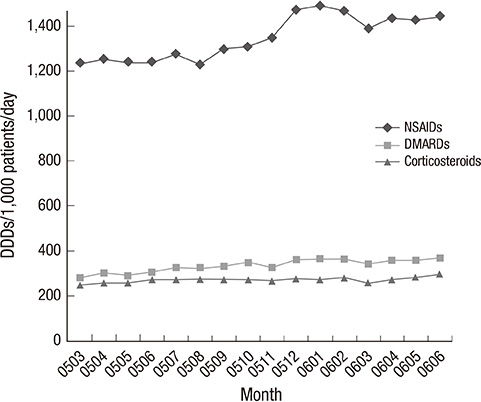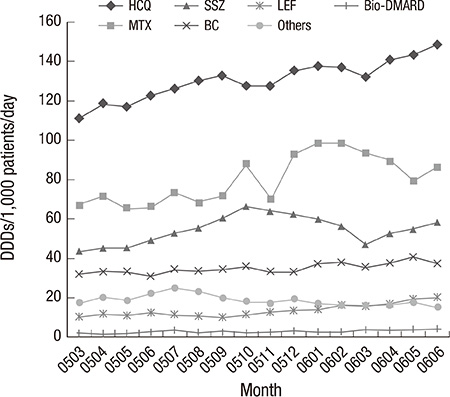J Korean Med Sci.
2014 Feb;29(2):210-216. 10.3346/jkms.2014.29.2.210.
Utilization Patterns of Disease-Modifying Antirheumatic Drugs in Elderly Rheumatoid Arthritis Patients
- Affiliations
-
- 1Department of Preventive Medicine, College of Medicine, Seoul National University, Seoul, Korea. bjpark@snu.ac.kr
- 2Medical Research Collaborating Center, Seoul National University Hospital, Seoul, Korea.
- 3Institute of Environmental Medicine, Seoul National University Medical Research Center, Seoul, Korea.
- 4Korea Institute of Drug Safety and Risk Management, Seoul, Korea.
- KMID: 1789977
- DOI: http://doi.org/10.3346/jkms.2014.29.2.210
Abstract
- This study was conducted to investigate disease-modifying antirheumatic drug (DMARD) utilization in Korean elderly patients with rheumatoid arthritis (RA). We used data from January 1, 2005 to June 30, 2006 from the Health Insurance Review and Assessment Service claims database. The study subjects were defined as patients aged 65 yr or older with at least two claims with a diagnosis of RA. DMARD use was compared by the patients' age-group, gender, medical service, and geographic divisions. The patterns of DMARD use in mono- and combination therapy were calculated. RA medication use was calculated by the number of defined daily doses (DDD)/1,000 patients/day. A total of 166,388 patients were identified during the study period. DMARD use in RA patients was 12.0%. The proportion of DMARD use was higher in the younger elderly, females, and patients treated in big cities. Hydroxychloroquine was the most commonly used DMARD in monotherapy, and most of the combination therapies prescribed it with methotrexate. DMARD use in elderly RA patients was noticeably low, although drug prescriptions showed an increasing trend during the study period, clinicians may need to pay more attention to elderly RA patients.
MeSH Terms
-
Age Factors
Aged
Aged, 80 and over
Antirheumatic Agents/*therapeutic use
Arthritis, Rheumatoid/*drug therapy
Databases, Factual
Drug Therapy, Combination
Female
Humans
Hydroxychloroquine/therapeutic use
Male
Methotrexate/therapeutic use
National Health Programs
Retrospective Studies
Sex Factors
Antirheumatic Agents
Hydroxychloroquine
Methotrexate
Figure
Reference
-
1. Wong JB, Ramey DR, Singh G. Long-term morbidity, mortality, and economics of rheumatoid arthritis. Arthritis Rheum. 2001; 44:2746–2749.2. Alamanos Y, Voulgari PV, Drosos AA. Incidence and prevalence of rheumatoid arthritis, based on the 1987 American College of Rheumatology criteria: a systematic review. Semin Arthritis Rheum. 2006; 36:182–188.3. Symmons DP. Epidemiology of rheumatoid arthritis: determinants of onset, persistence and outcome. Best Pract Res Clin Rheumatol. 2002; 16:707–722.4. Symmons D, Turner G, Webb R, Asten P, Barrett E, Lunt M, Scott D, Silman A. The prevalence of rheumatoid arthritis in the United Kingdom: new estimates for a new century. Rheumatology. 2002; 41:793–800.5. Howe N, Jackson R, Nakashima K. The aging of Korea: demographics and retirement policy in the land of the morning calm. Washington, D.C.: Center for Strategic and International Studies;2007.6. Guidelines for the management of rheumatoid arthritis: American College of Rheumatology Ad Hoc Committee on Clinical Guidelines. Arthritis Rheum. 1996; 39:713–722.7. Newsome G. American College of Rheumatology. Guidelines for the management of rheumatoid arthritis: 2002 update. J Am Acad Nurse Pract. 2002; 14:432–437.8. Gonzalez-Alvaro I, Carmona L, Balsa A, Sanmarti R, Belmonte MA, Tena X. EMECAR Study Group. Patterns of disease modifying antirheumatic drug use in a Spanish cohort of patients with rheumatoid arthritis. J Rheumatol. 2003; 30:697–704.9. Carli C, Ehlin AG, Klareskog L, Lindblad S, Montgomery SM. Trends in disease modifying antirheumatic drug prescription in early rheumatoid arthritis are influenced more by hospital setting than patient or disease characteristics. Ann Rheum Dis. 2006; 65:1102–1105.10. Health Insurance Review & Assessment Service. Health Insurance Index 2006. accessed on 24 July 2013. Available at http://www.hira.or.kr/dummy.do?pgmid=HIRAA020045030000&cmsurl=/cms/information/05/03/03/1192956_13609.html.11. WHO Collaborating Center for Drug Statistics Methodology. Guidelines for ATC classification and DDD assignment 2013. accessed on 24 July 2013. Available at http://www.whocc.no/filearchive/publications/1_2013guidelines.pdf.12. WHO Collaborating Center for Drug Statistics Methodology. ATC/DDD Index 2013. accessed on 24 July 2013. Available at http://www.whocc.no/atc_ddd_index.13. Ministry of Food and Drug Safety. Ezdrug. accessed on 24 July 2013. Available at http://ezdrug.mfds.go.kr.14. Schmajuk G, Schneeweiss S, Katz JN, Weinblatt ME, Setoguchi S, Avorn J, Levin R, Solomon DH. Treatment of older adult patients diagnosed with rheumatoid arthritis: improved but not optimal. Arthritis Rheum. 2007; 57:928–934.15. Schmajuk G, Trivedi AN, Solomon DH, Yelin E, Trupin L, Chakravarty EF, Yazdany J. Receipt of disease-modifying antirheumatic drugs among patients with rheumatoid arthritis in Medicare managed care plans. JAMA. 2011; 305:480–486.16. Edwards CJ, Arden NK, Fisher D, Saperia JC, Reading I, Van Staa TP, Cooper C. The changing use of disease-modifying anti-rheumatic drugs in individuals with rheumatoid arthritis from the United Kingdom General Practice Research Database. Rheumatology (Oxford). 2005; 44:1394–1398.17. Khanna R, Smith MJ. Utilization and costs of medical services and prescription medications for rheumatoid arthritis among recipients covered by a state Medicaid program: a retrospective, cross-sectional, descriptive, database analysis. Clin Ther. 2007; 29:2456–2467.18. Grijalva CG, Chung CP, Stein CM, Mitchel EF Jr, Griffin MR. Changing patterns of medication use in patients with rheumatoid arthritis in a Medicaid population. Rheumatology (Oxford). 2008; 47:1061–1064.19. Widdifield J, Bernatsky S, Paterson JM, Thorne JC, Cividino A, Pope J, Gunraj N, Bombardier C. Quality care in seniors with new-onset rheumatoid arthritis: a Canadian perspective. Arthritis Care Res (Hoboken). 2011; 63:53–57.20. Fries JF, Williams CA, Morfeld D, Singh G, Sibley J. Reduction in long-term disability in patients with rheumatoid arthritis by disease-modifying antirheumatic drug-based treatment strategies. Arthritis Rheum. 1996; 39:616–622.21. Hur NW, Choi CB, Uhm WS, Bae SC. The prevalence and trend of arthritis in Korea: results from Korea National Health and Nutrition Examination Surveys. J Korean Rheum Assoc. 2008; 15:11–26.22. Rachapalli SM, Williams R, Walsh DA, Young A, Kiely PD, Choy EH. Early Rheumatoid Arthritis Network. First-line DMARD choice in early rheumatoid arthritis: do prognostic factors play a role? Rheumatology (Oxford). 2009; 49:1267–1271.23. Montag K, Gingold M, Boers A, Littlejohn G. Disease-modifying anti-rheumatic drug usage, prescribing patterns and disease activity in rheumatoid arthritis patients in community-based practice. Intern Med J. 2011; 41:450–455.24. Sung YK, Cho SK, Choi CB, Bae SC. Prevalence and incidence of rheumatoid arthritis in South Korea. Rheumatol Int. 2013; 33:1525–1532.25. Health Insurance Reviw & Assessment Service. Major activities of HIRA. accessed on 24 July 2013. Available at http://www.hira.or.kr/eng/activity/01/01/activity01_01.html.26. Park BJ, Sung JH, Park KD, Seo SW, Kim SW. Report of the evaluation for validity of discharged diagnoses in Korean Health Insurance database. Seoul: Seoul National University College of Medicine;2003.27. Cho SK, Sung YK, Choi CB, Kwon JM, Lee EK, Bae SC. Development of an algorithm for identifying rheumatoid arthritis in the Korean National Health Insurance claims database. Rheumatol Int. 2013; 33:2985–2992.
- Full Text Links
- Actions
-
Cited
- CITED
-
- Close
- Share
- Similar articles
-
- Medical Treatment of Rheumatoid Arthritis
- Disease Modifying Antirheumatic Drugs in Rheumatoid Artritis
- Medical treatment of rheumatoid arthritis (I): Nonsteroidal anti-inflammatory drugs, disease modifying antirheumatic drugs and glucocorticoids
- Cementless Total Knee Arthroplasty and Effects of Disease Modifying Anti-Rheumatic Drugs in Rheumatoid Arthritis
- Treatment of juvenile rheumatoid arthritis




